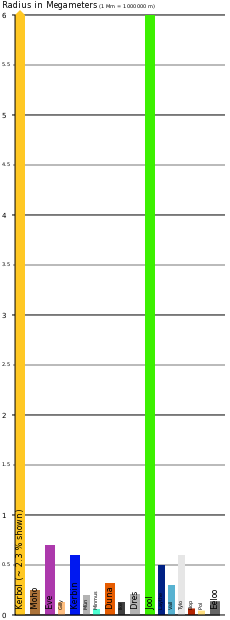Difference between revisions of "Kerbol System"
(fixed mistake) |
(clean up formatting, typos fixed: Comparision → Comparison) |
||
| Line 1: | Line 1: | ||
[[File:Bodies of Kerbol en.png|thumb|All [[celestial body|celestial bodies]] orbiting Kerbol with the sizes to scale]] | [[File:Bodies of Kerbol en.png|thumb|All [[celestial body|celestial bodies]] orbiting Kerbol with the sizes to scale]] | ||
| − | [[File:sizes.svg|thumb| | + | [[File:sizes.svg|thumb|Comparison of the radii|upright]] |
The '''Kerbol System''' is at the moment the only available [[w:Planetary system|planetary system]]. It has [[Kerbol]] as the central body which is orbited by 5 [[planet]]s and 2 [[dwarf planet]]s. Only [[Kerbin]] and [[Laythe]] have an oxygen atmosphere and only Kerbin hosts life. | The '''Kerbol System''' is at the moment the only available [[w:Planetary system|planetary system]]. It has [[Kerbol]] as the central body which is orbited by 5 [[planet]]s and 2 [[dwarf planet]]s. Only [[Kerbin]] and [[Laythe]] have an oxygen atmosphere and only Kerbin hosts life. | ||
| − | With the outermost dwarf planet [[Eeloo]] it reaches up to | + | With the outermost dwarf planet [[Eeloo]] it reaches up to 113 549 713 200 m (about 113.5 [[w:Gigametre|Gm]] or 0.76 [[w:Astronomical unit|AU]]) out into space. Compared to our Solar System it is a very small system, as Earth's periapsis (or more specific perihelion) is about 147 Gm (or 0.98 AU) and thus outside of Eeloo's orbit. |
It is difficult to determine if or where the Kerbol System has an edge. Kerbol itself has a non relativistic escape velocity, so it is possible to escape Kerbol. But itself it is not possible to escape Kerbol's gravitational pull, because the sphere of influence is infinite. Although real world gravity expands into infinity, it does only for Kerbol in KSP so it's unclear if this property can be used for determinate where the edge is. | It is difficult to determine if or where the Kerbol System has an edge. Kerbol itself has a non relativistic escape velocity, so it is possible to escape Kerbol. But itself it is not possible to escape Kerbol's gravitational pull, because the sphere of influence is infinite. Although real world gravity expands into infinity, it does only for Kerbol in KSP so it's unclear if this property can be used for determinate where the edge is. | ||
| − | [[File: | + | [[File:kerbol sizecomp chart.jpg|thumb|600px|center|Graphical comparison of the main celestial bodies in the Kerbol System (sizes to scale)]] |
[[File:orbits.svg|thumb|upright=4.5|Orbits of planets and dwarf planets|center]] | [[File:orbits.svg|thumb|upright=4.5|Orbits of planets and dwarf planets|center]] | ||
Revision as of 01:14, 7 April 2014
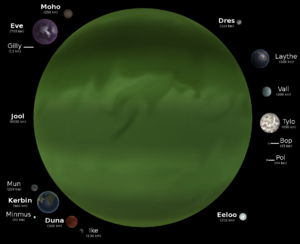
The Kerbol System is at the moment the only available planetary system. It has Kerbol as the central body which is orbited by 5 planets and 2 dwarf planets. Only Kerbin and Laythe have an oxygen atmosphere and only Kerbin hosts life.
With the outermost dwarf planet Eeloo it reaches up to 113 549 713 200 m (about 113.5 Gm or 0.76 AU) out into space. Compared to our Solar System it is a very small system, as Earth's periapsis (or more specific perihelion) is about 147 Gm (or 0.98 AU) and thus outside of Eeloo's orbit.
It is difficult to determine if or where the Kerbol System has an edge. Kerbol itself has a non relativistic escape velocity, so it is possible to escape Kerbol. But itself it is not possible to escape Kerbol's gravitational pull, because the sphere of influence is infinite. Although real world gravity expands into infinity, it does only for Kerbol in KSP so it's unclear if this property can be used for determinate where the edge is.
See also
- Kerbol System/Table for a table of all objects
System
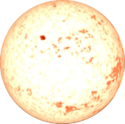 Kerbol Kerbol
| ||||||
 Moho Moho
| ||||||
 Eve Eve
|
 Gilly Gilly
| |||||
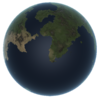 Kerbin Kerbin
|
 Mun Mun
|
 Minmus Minmus
| ||||
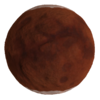 Duna Duna
|
 Ike Ike
| |||||
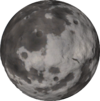 Dres Dres
| ||||||
 Jool Jool
|
 Laythe Laythe
|
 Vall Vall
|
 Tylo Tylo
|
 Bop Bop
|
 Pol Pol
|
|
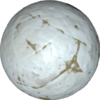 Eeloo Eeloo
| ||||||
| (Sizes and distances not to scale) | ||||||
